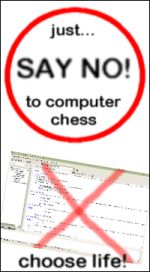Hi, in some (few) places i have read about "Static Null Move", what is it?
Another (maybe) related question, mainly for Tord: in Glaurung 1 i have found some code that performed a global SEE, to try the equivalent of null moves in low depth nodes. Wasn't it worth including in Glaurung 2 too?
Regards!
Static Null Move?
Moderators: hgm, Rebel, chrisw
-
Tord Romstad
- Posts: 1808
- Joined: Wed Mar 08, 2006 9:19 pm
- Location: Oslo, Norway
Re: Static Null Move?
You just answered your own question: Static null move pruning is null move pruning without a search. If the static evaluation is high above beta, the remaining depth is low, and perhaps some additional conditions are satisfied, a static analysis of hanging pieces (and possibly other threats) is done, and if no sufficiently serious threat is found, beta is returned.Ratta wrote:Hi, in some (few) places i have read about "Static Null Move", what is it?
Another (maybe) related question, mainly for Tord: in Glaurung 1 i have found some code that performed a global SEE, to try the equivalent of null moves in low depth nodes.
The technique was very popular in the 1980s and 1990s, but it seems to be out of fashion at the moment. I am not sure why so few people are using it. In my experience, it performs at least as well as dynamic null move pruning in the last two or three plies of search (static null move pruning is obviously less accurate, but this is compensated by the smaller tree size).
Absolutely. I will try it some day, but there are such a lot of things waiting to be tested...Wasn't it worth including in Glaurung 2 too?
Tord
-
Ratta
Re: Static Null Move?
Ok, thanks for the answers!
When i have some time and my SMP search function stops crashing i will be happy to try something like this too...
When i have some time and my SMP search function stops crashing i will be happy to try something like this too...
-
Thomas Mayer

- Posts: 385
- Joined: Thu Mar 09, 2006 6:45 pm
- Location: Nellmersbach, Germany
Re: Static Null Move?
Ah Tord,Tord Romstad wrote:You just answered your own question: Static null move pruning is null move pruning without a search. If the static evaluation is high above beta, the remaining depth is low, and perhaps some additional conditions are satisfied, a static analysis of hanging pieces (and possibly other threats) is done, and if no sufficiently serious threat is found, beta is returned.Ratta wrote:Hi, in some (few) places i have read about "Static Null Move", what is it?
Another (maybe) related question, mainly for Tord: in Glaurung 1 i have found some code that performed a global SEE, to try the equivalent of null moves in low depth nodes.
The technique was very popular in the 1980s and 1990s, but it seems to be out of fashion at the moment. I am not sure why so few people are using it. In my experience, it performs at least as well as dynamic null move pruning in the last two or three plies of search (static null move pruning is obviously less accurate, but this is compensated by the smaller tree size).
Absolutely. I will try it some day, but there are such a lot of things waiting to be tested...Wasn't it worth including in Glaurung 2 too?
Tord
now I know how it is called what I was doing for a long time in Quark... I just stopped it lately after implementing kind of LMR... Together it doesn't seem to work well... (But you achieve amazing depth...
Greets, Thomas
-
Uri Blass
- Posts: 10282
- Joined: Thu Mar 09, 2006 12:37 am
- Location: Tel-Aviv Israel
Re: Static Null Move?
I doubt if you know what is popular todayTord Romstad wrote:You just answered your own question: Static null move pruning is null move pruning without a search. If the static evaluation is high above beta, the remaining depth is low, and perhaps some additional conditions are satisfied, a static analysis of hanging pieces (and possibly other threats) is done, and if no sufficiently serious threat is found, beta is returned.Ratta wrote:Hi, in some (few) places i have read about "Static Null Move", what is it?
Another (maybe) related question, mainly for Tord: in Glaurung 1 i have found some code that performed a global SEE, to try the equivalent of null moves in low depth nodes.
The technique was very popular in the 1980s and 1990s, but it seems to be out of fashion at the moment. I am not sure why so few people are using it. In my experience, it performs at least as well as dynamic null move pruning in the last two or three plies of search (static null move pruning is obviously less accurate, but this is compensated by the smaller tree size).
Absolutely. I will try it some day, but there are such a lot of things waiting to be tested...Wasn't it worth including in Glaurung 2 too?
Tord
Most of the programs are not open source.
Uri